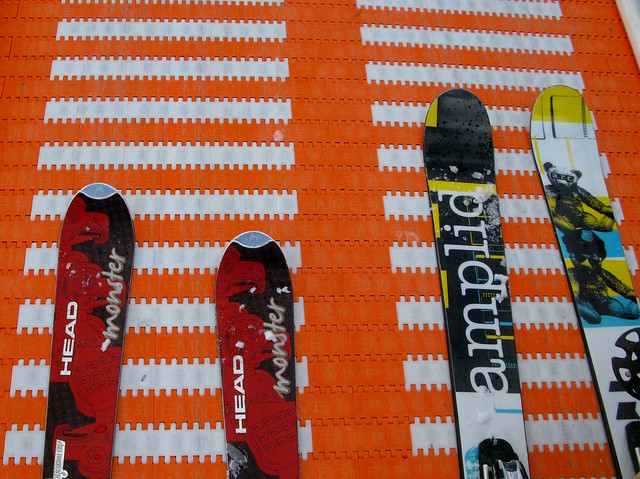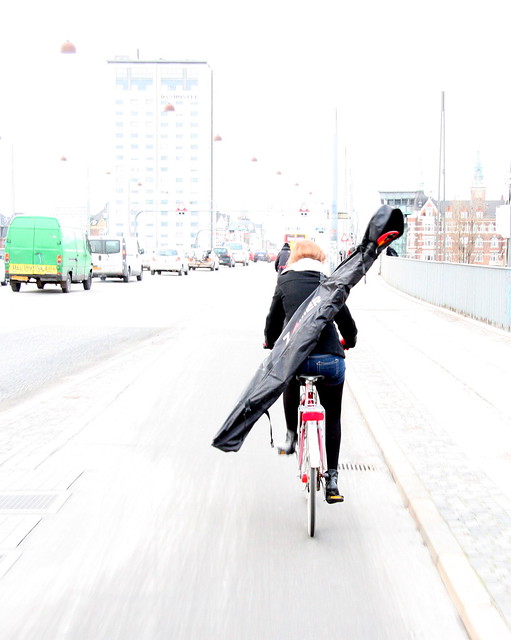

We got sent a link to a page from the Danish Consumer Council (Forbrugerrådet)about ski helmets. It was interesting reading because of a confusing mix of Culture of Fear (for profit) and the science of helmets. And much of it is a mirror of the rhetoric about bicycle helmets. Ski and bicycle helmets are even compared. The article starts with the standard emotional propaganda in the first few lines:
Ski helmets can reduce the number of injuries by up to 60%, BUT roughly half of adults ski without head protection.
Would you ride 40 km/h on a scooter without a helmet? If you answer no, then why ski 60 km/h down a piste without a helmet?
According to statistics, head injuries are not the typical reason that a ski holiday ends up in a hospital. Concussions made up 9% of all reported injuries last season. This is a rise of 5-6% from the year before.
So... head injuries are not typical injuries. Um. Okay. But head injuries are up? From the season before last to last season, there was little dramatic increase in the number of helmet wearers, and yet head injuries are up? Boy, that sounds like Risk Compensation at play. Are people feeling protected so they go just a bit faster?
According to statistics from Denmark's Ski Union, the total number of injuries are two per 1000 ski days for skiiers. Head injuries make up about 15%. In other words, the risk of a head injury is one per 3000 ski days - or one head injury every 400 years if someone skiis for one week each year.
So I have to ski for 400 years? Personally, I've probably skied about 400-500 days in my life. While I love the thought of skiing for 400 years, I don't know many people who will.
The potentially dangerous brain injuries make up one injury for every 14,000 ski days and 94% of them are concussions. Okay. This is rare information. Normally, the phrase "brain injury" is happily chucked around in the rhetoric without any differentiation in order to scare and confuse. Yes, a serious concussion can be life-threatening and dangerous. Most aren't. I've had several in my life. None whilst skiing or cycling, but hey, that's just me. This article that started out with a scary paragraph is turning out to be rather informative.
Snowboarders have a bit higher risk of head injury than alpine skiers and children under 18 have more than double the risk.
Does that mean kids have to ski for 200 years - before they're 18?The Helmet protects partially
Ski helmets aren't built to withstand direct impacts in speeds over 20 km/h. Measurements at several destinations have shown that the average speed on the easier pistes is around 30 km/h - and much higher on the medium and difficult pistes. If a head hits a tree, rock, other skiers or chairlift poles at high speeds, the helmet offers no protection. Hang on... rewind to the first paragraph. I thought they were fingerpointedly telling me that I needed a ski helmet at 60 km/h. Now they're telling me that it won't really do anything for me. I'm so confused. Interestingly, as I'm sure you all know, the same limitations apply to bicycle helmets. No direct impacts and keep it under 20 km/h.
The helmet's benefits are limited to minor head lesions like scratches and cuts on the scalp and minor concussions.
Sounds like a bicycle helmet again. Actually, it sounds like something everyone should wear in the home and certainly in the car. But hey... they were throwing around all manner of confusing stats on "brain injuries" and concussions, weren't they? Again... I'm confused.
In all collisions, the helmet protects in glancing collisions and protects against getting hit by ski edges and other loose objects, just like it protects when your head hits a hard snow surface and when you tumble off a t-bar lift.
Which, we assume, means it protects against hitting your head against the cupboard door or if you slip in the shower. Or if you're out gardening. Good to know.
The Ski Union recommends helmets
The International Ski Union - FIS - recommended a couple of years ago that all skiiers and snowboarders use a helmet. FIS based their recommendation on a Norwegian study published in the Journal of the American Medical Association. The study showed that using a helmet reduces head injuries by 60%.
But isn't the FIS a sports organisation? You know, professionals going super fast in order to win medals? A far cry from Citizen Skiers. Kind of like the forms you have to fill out in America to ride through a park at low speeds. Based on this logic, why doesn't the company behind Formula 1 car racing recommend motorist helmets? FIS based their recommendations on one study. Were there others? What was the collective result of the different studies? Why base it on just one? Here the information dries up.
FIS also deals with cross-country skiing. You'd think that these athletes would be better off wearing helmets if they protect against tumbling onto the ground and getting a glancing blow by a ski or other object.Also, is the FIS sponsored by a helmet company? Duh. Of course they are.
The helmet's strength is a compromise between strength and comfort. If ski and bicycle helmets had the same strength as motorcycle helmets, nobody would bother wearing them.
So a motorcycle helmet is better since a ski or bicycle helmet is just a question of comfort more than protection?Every second adult skis without a helmet Here in Denmark, experts used to only recommend helmets for kids and other risk groups like young men with an aggressive skiing style.
Denmark's Ski Union recommends helmet use, especially by kids and youths and if you participate in high-risk snow sport competitions and training in the snowboard park and off-piste, but the Ski Union doesn't support a helmet law.
Yes, you said that bit about every second adult up at the top. Just slapping in another guilt trip for good measure, are we? Interestingly, the Danish Ski Union has an entire page telling people how safe skiing is. "It's dangerous!... Uh... no it isn't..."
No law yet...
A law can be a reality in the future. Both in Italy and Austria children under 15 have to wear them. In Northern Europe there is no law, but many places let children use the lifts free if they're wearing a helmet. Therefore, it's rare to see a child without a ski helmet in Norway or Sweden.
Dealers that the Consumer Council have spoken with think that half of all adult skiers ski with head protection and for children the number is close to 100%. The reasons include the fact that the pistes are groomed for high speeds, so that even weaker skiers can ski faster. And many people traverse the busy pistes. Conditions that increase the risk of collision.
Traversing a piste? Isn't that just called skiing? And the risk of collision... the article told us all about that farther up.Ski with care
Collisions on the pistes cannot be avoided if everyone wears protective gear, but by showing responsibility for yourself and others. Respect your technical level, be aware, adjust your speed to the conditions and keep your distance from other skiers. THAT took us by surprise. We were totally expecting the whole article to end where it started, not with this sensible, rational advice. While the article DID start out with the usual verbal diarrhea from the safety slash profit crowd, we are left wishing that all "advice" about skiing - or cycling - provided the reader with rational facts and statistics so that the individual was able to make up their own mind instead of merely being subjected to fear rants. It's a hard slog at this point in our society, we know that. The Culture of Fear has a firm grip. Sitting in the café at a small Swedish ski resort - with five or six measly, ten turn pistes - an hour and a half from Copenhagen, I was amazed to see so many people sitting there with their jackets off and their backs protected with Terminator-like back shields, like they were characters in a wintry Call of Duty-Black Ops 2 level. Having bought into the fabricated gear myth presented to them at every turn.
What you can mine from this article is the fact that if you put a helmet on your kids when skiing - to get those free lift tickets - you can just use their bicycle helmet if they have one of those. Save some money right there. Just don't let them use them at the ice rink, because bicycle helmets (and ski helmets we figure) aren't allowed at some ice rinks... Yes. We're confused, too.





